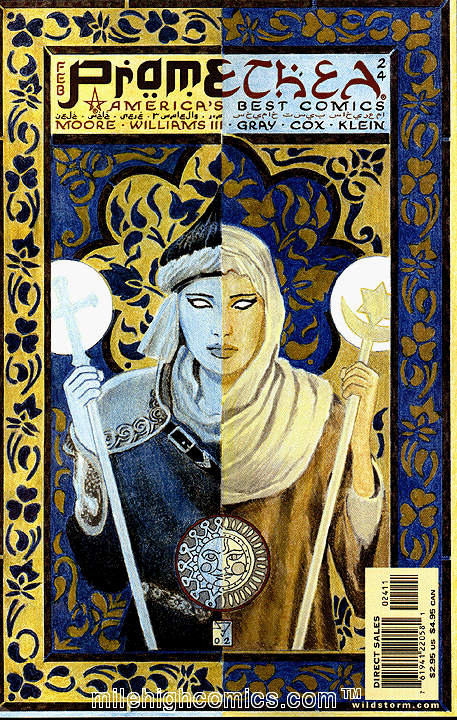
TITLE:
As can be seen on the cover the Cross refers to Christianity while the Star and the Moon are symbols of Islam
TL Wrote to tell me about the title
The first part could refer to Christianism and Islam. "shapes in the sand" reminds me of an anecdote told about the Greek philosopher Aristippos: He was shipwrecked and landed on a solitary island. But he found figures in the sand and concluded that there were men. The story must be in Diogenes Laertios, Life of the philosophers.
The only reference to shapes in the sand I could find on the net was from Aristotle's History of Animals Book IV Part 10
and a small mention with regards to
Pythagoras
Shapes in the sand also reminds me of
SYNOPSIS:
For the first time we learn about two other incarnations of Promethea who existed in our world (one Christian and the other Muslim) flourishing before the 11th Century, leaving to spend time in their respective heavens and returning to our world still unaware of each others’ existence eventually fighting each other to death on opposite sides at the battle of Antioch in 1097 AD.
Juxtaposed with their story is that of Sophie and her former best friend Stacia who fight one another in their guises as Promethea and knock each other out.
From the Immateria the previous Prometheas Margaret, Bill and Anna open up a doorway and take them out of our world.
QUOTES:
God fostered child made living tale that the imaginative might put on like pearls, or armor. So the story went. – pg 1
Wind drew serpent-trails between the dunes. In this way, many years were passed. – pg.1
“This Promethea thing, it’s great, but it ain’t a future. You don’t want it screwing up your grades." - Trish Bangs,. Pg 3
“So, Sophie, this Kaballah: did you meet God? Give him any good advice?” – Stacia, pg. 5
“I’ve been appointed Promethea by the highest power there is! And what, you think just because you’ve got your dykey little crush on Grace, all that changes?” – Sophie, pg. 6
And the years were like grains pouring in the Present’s hourglass throat, down into spent, still Past out of a crumbling and uncertain future. – pg. 9
“I am Grace #%$@ing Brannagh, Darling, and I’m the best there’s ever been.” – Promethea(3b), pg 10
“Either we stop this now and work things out, or it’s war between us.” – Promethea(6)
“Fair enough. Then it’s war.” – Promethea(3b), pg 13
“Dear God. They’re fighting. This is unprecendented.” – Promethea(2)
“I---I dunno, Margaret, honey. I’m getting real deja-vu here…” – Promethea(4)
“Mistress Bill speaks truly. This happened before.” – Promethea(1), pg 17
And within each of them, the spirit-child Promethea, divided in itself, began to weep and grow afraid, and yet did not know why. – pg. 18
At last, locked in their death-grip, two religions looked into each other’s eyes and recognized themselves. Knew then that both were halves of what had been one holy, undivided source. – pg. 19
And the Promethea spirit, reunited with herself, held in her scream of horror, wiped the schism from her mind, forgot it quite…until a great while later. – pg. 19
“Margaret sweetheart, we shouldn’t open a doorway like this. Only demons do that stuff.” – Promethea(4)
“Bill, this is an emergency. We’ve got to limit the damage that’s already been done.” – Promethea(2), pg 24
NOTES & ANNOTATIONS:
First the Barbelith Underground commentary on this issue.
As TL notes
The aesthetical principle of this issue is symmetry and correspondance, most of the double pages are constructed like triptychs. There is a duality between East and West, past and present, Sophie and Stacia. The dominant colours are blue, yellow and red (blue for Islam, yellow for Christianity, maybe because the Orient is the land of the rising sun, whereas the Occident is the land of the sundown).
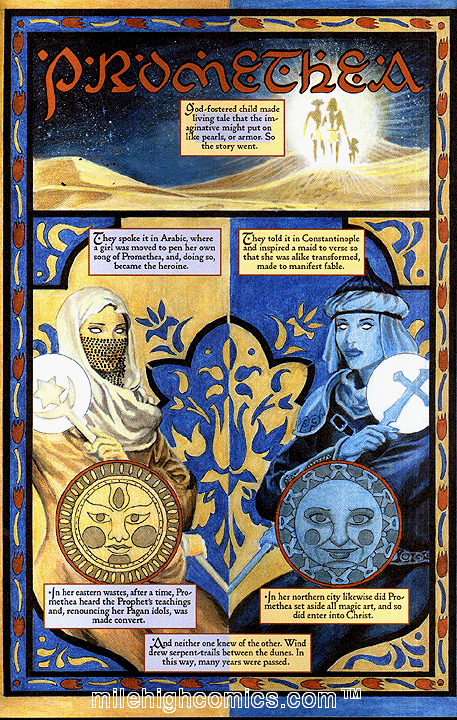
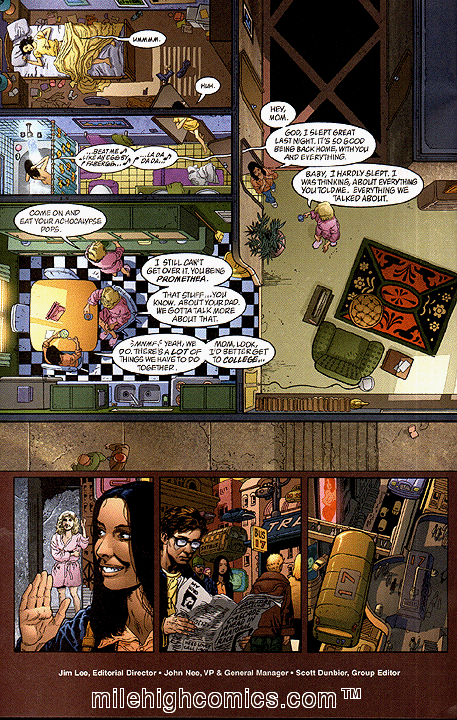
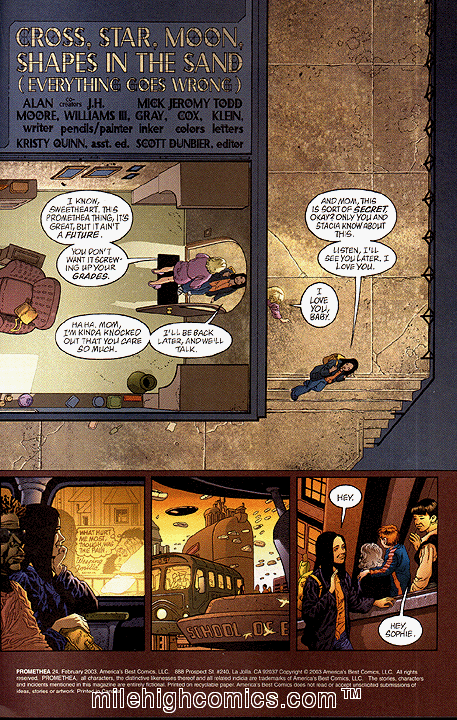

The proper description of this type of image is chessecake warplane nose art. A major exponent was Alberto Vargas.
Note that Stacia is wearing a number 1 T shirt and showing her belly button.
Panel 3: Does anyone recognize the Thor like figure on the back of this student’s jacket?
Panel 4: The Blow Meez sound like another band.
Page 5 Panel 4:
Note the reflection of Stacia's glasses.
Pages 6-7: The school of Elevated Minds becomes the Lightning Struck Tower. Clouds are exactly the same but it is now as dark as night.
TL notes
The kabbalistic symbol is the Tower as in issue 15. Crowley explains in the "Book of Thoth", that the tower stands for war and the destruction of matter by fire. Crowley also refers the "Tower" to Book of the law I,57, where the goddess Nuith speaks of a "fortress" and mentions "the dove and the snake" (motto of Promethea # 23). Dove and serpent stand for Schopenhauer's "the will to life" and the "will to death" (Eros and Thanatos), and one could speculate that these two tendencies are embodied by Sophie and Stacia in issue # 24. Thus there would be a hidden symbolical link between issue # 23 and # 24. The kabbalistic discourse goes on, even if the narrative shows the usual clash of superheroes.
Pages 8-9:
Houris definitions are:
A voluptuous, alluring woman.
One of the beautiful virgins of the Koranic paradise.
from Dictionary.com
Elysium
definitions:
A place or condition of ideal happiness.
A dwelling place assigned to happy souls after death; the seat of future happiness; Paradise.
a heavenly place--peaceful and beautiful--where those who are favored by the gods can go when they die.
also from Dictionary.com
The Story of Jesus throwing the money changers out of the Temple can be found in:
Matthew 21:12
Mark 11:15 and
John 2:15
The last written panel seems like a send up of the old Days of Our Lives introduction
“Like grains through the hour glass these are the days of our lives”.
Also used by So-Crates in Bill and Ted’s Excellent Adventure

Pages 10-11: Promethea(6) now wears the red cape she acquired in her journey through the Tree of Life.
Pages 12-13: The snakes on the caduceus each bite one another.
I thought the whiteness of the snakes at the bottom of the page gave it a slightly unfinished look as though the colorist didn't have time to finish making them blue but as JHW3 notes:
the snakes at the end of issue 24 are actually the way they look now. If you will notice the line around them is dulled and they are putting off a white glow.
After all she has been to heaven and so have the snakes so we thought it appropriate for them and all of her energy fx and glowing floating stars to now be white, the dominant color of kether.
I meant for it to be that way as well. Just flat white. It has an almost clean feeling to it.
Pages 14-15:
Jihad
A Muslim holy war or spiritual struggle against infidels.
A religious war against infidels or Mohammedan heretics; also, any bitter war or crusade for a principle or belief.
a holy war by Muslims against unbelievers
Definitions from Dictionary.com
1097 Antioch
One of the great cities of the Roman and Christian world, Antioch had only been captured by the Muslims in 1085, having been retained by Byzantium until then. It's capture was key to the success of the First Crusade - without control of Antioch, the crusaders could not have moved on to Jerusalem. The siege lasted for seven and a half months, and conditions for the crusaders were often worse than those inside the city. The city was located in the valley of the Orontes, in mountainous country. The city itself was on the valley floor, with the citadel high on the mountains above the city, but contained within the city walls. The crusaders put a blockade in place, building three siege towers, and settled down for a long siege. The Syrians made two attempts to relieve the city, defeated at the battles of Harene (1st battle 31 December 1097, 2nd battle 9 February 1098), and another large relief army under Emir Kerboga of Mosul, some 75,000 strong, was on its way when the city was captured. The eventual capture of the city was aided by treachery within the city. The Tower of the Two Sisters, at the base of the mountain, was held by the Beni-Zarra family, whose head, Firuz, who for personal reasons was willing to let the Franks in. Their break-in was aided by a Turkish plan to kill suspect Christians on the same night - the initial noises of the crusader break-in were mistaken for noises of the massacre. Firuz made his offer to Bohemond, who eventually persuaded the rest of the crusade to agree to give him Antioch as the basis of a principality. In his defence, Bohemond was the first man up the ladder into Antioch. From the Tower of the Two Sisters, the crusaders were able to open a postern gate, and make their way to the Gate of the Bridge, one of the main gates into the city. The city was soon in their hands, but the citadel on it's peak remained in Turkish hands, and only two days later the relief army arrived, beginning Kerboga's siege of Antioch.
Bradbury, Jim, The Medieval Siege pp.109-12
Details taken from here.
Here are the details of the events surrounding the Battle of Antioch.
Here is an overview of the First Crusade.
It reminds me of the imagery of Alan Moore’s Miracleman Olympus but not with as much graphic details.
Pages 16-17:
As Grace/Stacia and Promethea/Sophie fight the circle panels underneath them show the reactions of other characters as they learn about the fight.
I: Jack Faust with Tarot card.
Appropriately it is the one Crowley refers to as The Tower [or War].
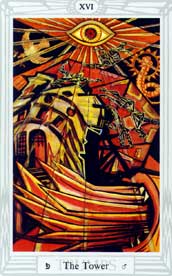
II: FBI agents Breughel and Ball.
III: Trish Bangs (Sophie’s mother) holding a Weeping Gorilla cup.
IV: The other 3 previous Prometheas and little Margie in the Immateria.
Pages 18-19: Nice mixing of past and present. Within the circles firstly One half Promethea(6) and one half the Christian Promethea and secondly the Islamic Promethea and Grace/Stacia version.
The panels also alternate between past and present on both pages.
Note that in the Antioch segment a Christian soldier gets up on page 18 panel 3, walks towards the two Promethea battling in panel 5, strikes both of them through with his lance on page 19 Panel 2, leaving them to spit out blood as they start to die in panel 4.
And the planes hit the buildings on September 11, 2001.
And the smartbomb hits the mosque on 25 October, 2001.
Following U.N. High Commissioner for Refugees confirmation Tuesday that U.S. bombing struck a military hospital Monday in Herat, UNHCR spokeswoman in Pakistan Stephanie Bunker said yesterday that U.S. bombs also hit a mosque in the same military compound and a nearby village.
"We take extraordinary care on the targeting process," said U.S. Assistant Defense Secretary Victoria Clarke. "There is unintended damage. There is collateral damage. Thus far, it has been extremely limited, from what we've seen.
from Global Secuirty Newswire.
The tanks roll over a demolished settlement in lots of places but most prominently the Palestine/Israeli conflict.
The pretty student in the shopping precinct gets exactly halfway though her last defiant prayer I assume this is a reference to a female suicide bomber.
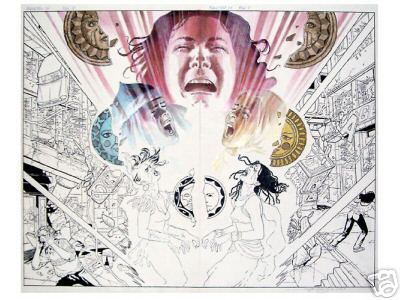
Page 20-21: Four different sun symbols split in half. The original little girl Promethea cries out on top followed by the Islamic and Christian Prometheas and finally the two present day Promehteas.
Not sure about the cat on the left and the fish on the right. Limp concert poster torn apart at a bus stop(?) appropriately numbered 13.
Page 22: Agent Brueghel reminds me a bit of Trish Bangs here.
Page 23: Note the eyes behind the 3 previous Prometheas. Also the 3 leaf clover on the Clover’s store sign.
Page 24 Panel 1: the Margaret and Bill versions of Promethea are huge as our present day Prometheas fit like miniature dolls into the palms of their hands
Eyes visible in panels 1 and 3.
Panel 3:
Subject 1901-1920: Margaret Taylor Case.
Subject 1941-1970: Bill Woolcott.
Note that the caduceus flies above Promethea(6).
Ending panel reminds me of the last page of Issue #2